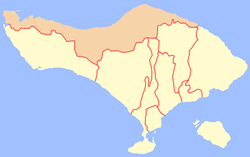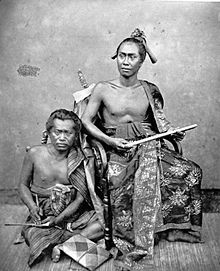Buleleng Regency
Buléléng | |
|---|---|
 | |
| Motto: Singa Ambaraja | |
 Location within Bali | |
| Country | |
| Province | |
| Capital | Singaraja |
| Government | |
| • Regent | Putu Agus Suradnyana |
| Area | |
| • Total | 527.37 sq mi (1,365.88 km2) |
| Population (mid 2022 estimate)[1] | |
| • Total | 791,810 |
| • Density | 1,500/sq mi (580/km2) |
| Demographics | |
| • Ethnic groups | Balinese Bali Aga |
| • Religion | Hinduism (Balinese Hinduism • folk Hinduism) |
| • Languages |
|
| Time zone | Indonesia Central Time |
| Area code | (+62) 362 |
| Website | bulelengkab.go.id |



Buleleng, officially Buleleng Regency (Balinese: ᬓᬩᬸᬧᬢᬾᬦ᭄ᬩᬸᬮᭂᬮᭂᬂ, romanized: Kabupatén Buléléng;
Indonesian: Kabupaten Buleleng), is a regency (kabupaten) of Bali Province, Indonesia. It stretches along the north side of the island of Bali from the Bali Strait in the west (separating Bali from East Java) almost to the eastern end of the island. It has an area of 1,365.88 km2 and a population of 624,125 at the 2010 census[2] and 791,910 at the 2020 census;[3] the official estimate as of mid-2022 was 825,141.[1] Its regency seat is in the town of Singaraja.
Buleleng was founded as a kingdom by Gusti Panji Sakti, who ruled c. 1660-c. 1700. He is commemorated as a heroic ancestor figure who expanded the power of Buleleng to Blambangan on East Java.[4] The kingdom was weakened during its successors and fell under the suzerainty of the neighbouring Karangasem kingdom in the second half of the 18th century. It was headed by an autonomous branch of the Karangasem Dynasty in 1806–1849.
The Dutch attacked Buleleng in 1846, 1848, and 1849, and defeated it on the last occasion.[5] Buleleng was incorporated into the Dutch colonial system and lost its autonomy in 1882. In 1929 a descendant of Gusti Panji Sakti, the renowned scholar Gusti Putu Jelantik, was appointed regent by the Dutch. He died in 1944, during the Japanese occupation of the Dutch East Indies. His son was a well-known novelist, Anak Agung Nyoman Panji Tisna. In 1947, Anak Agung Pandji Tisna surrendered the throne to his younger brother, Anak Agung Ngurah Ketut Djelantik, known as Meester Djelantik, until 1950. In 1949-50 Buleleng, like the rest of Bali, was incorporated into the unitary republic of Indonesia.
- ^ a b Badan Pusat Statistik, Jakarta, 2023, Kabupaten Buleleng Dalam Angka 2023 (Katalog-BPS 1102001.5108)
- ^ Biro Pusat Statistik, Jakarta, 2011.
- ^ Badan Pusat Statistik, Jakarta, 2021.
- ^ H.J. de Graaf, 'Goesti Pandji Sakti, vorst van Boeleleng', Tijdschrift voor Indische Taal-, Land- en Volkenkunde 83:1 1949.
- ^ Pringle, pp. 96-100
